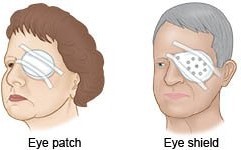The nurse is providing care to a client having surgery to repair a retinal detachment to the left eye. Which intervention should the nurse implement during the postoperative period?
Obtain vital signs every 2 hours during hospitalization.
Provide an eye shield to be worn while sleeping.
Teach a family member to administer eye drops.
Encourage deep breathing and coughing exercises.
The Correct Answer is B
After retinal detachment surgery, it is crucial to protect the eye and the surgical repair site from accidental trauma or pressure. Providing an eye shield helps to shield the eye during sleep when the client may not have conscious control over their movements.
This can help prevent inadvertent rubbing or bumping of the eye, which could potentially disrupt the surgical repair and hinder the healing process.
Obtaining vital signs every 2 hours during hospitalization is a routine nursing intervention for postoperative care in general but is not specific to retinal detachment surgery. The frequency of vital sign monitoring may vary depending on the client's overall condition and the healthcare provider's orders.
Teaching a family member to administer eye drops may be necessary for the client's ongoing care, but it is not specifically related to the immediate postoperative period. Eye drop administration instructions can be provided as part of the client's discharge teaching.
Encouraging deep breathing and coughing exercises is a general postoperative intervention that promotes respiratory function and helps prevent complications such as pneumonia. While important for overall postoperative care, it is not specific to retinal detachment surgery.

Nursing Test Bank
Naxlex Comprehensive Predictor Exams
Related Questions
Correct Answer is A
Explanation
Wearing protective goggles is important during suctioning to protect the nurse's eyes from potential splashes or aerosolized secretions. Suctioning can generate forceful coughing, gagging, or sneezing in the client, which may cause secretions or mucus to be expelled forcefully and potentially come into contact with the nurse's eyes. Wearing goggles helps prevent eye exposure and reduces the risk of infection transmission.
Applying a water-soluble lubricant to the catheter may be necessary to facilitate the insertion of the suction catheter into the tracheostomy tube, but it is not the most crucial action to include when performing suctioning.
Instilling normal saline before suctioning is not recommended as it can cause potential harm to the client's airway. Instilling saline can lead to bronchospasm, mucosal damage, and other complications. Suctioning should only be performed when necessary to remove secretions and maintain a patent airway.
Instructing the client to cough as the suction tip is removed is not necessary or recommended. Coughing during the suctioning process can be uncontrolled and may increase the risk of trauma to the airway. The nurse should instead provide supportive care and reassurance to the client throughout the procedure.
Correct Answer is C
Explanation
In this scenario, the child with a congenital heart defect is presenting with a fever and an
earache. The mother expresses concern about the child's weight and height being at the 5th percentile for his age. Given the child's medical history of a congenital heart defect, it is important for the nurse to address the mother's concerns and provide an accurate response.
The response that states "His smaller size is probably due to the heart disease" is appropriate because children with congenital heart defects may experience growth and developmental delays. Heart defects can affect the child's ability to obtain sufficient nutrients for growth, leading to slower weight and height gain. By acknowledging the relationship between the child's heart disease and his smaller size, the nurse provides the mother with an explanation for the child's growth pattern and helps alleviate concerns.
The other response options are not appropriate or helpful. Asking about the child's mental abilities or implying that the mother has not been feeding the child adequately can be perceived as judgmental or dismissive.
Whether you are a student looking to ace your exams or a practicing nurse seeking to enhance your expertise , our nursing education contents will empower you with the confidence and competence to make a difference in the lives of patients and become a respected leader in the healthcare field.
Visit Naxlex, invest in your future and unlock endless possibilities with our unparalleled nursing education contents today
Report Wrong Answer on the Current Question
Do you disagree with the answer? If yes, what is your expected answer? Explain.
Kindly be descriptive with the issue you are facing.
